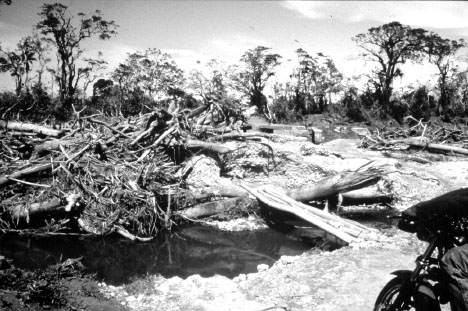The University Record, December 21, 1998
U helps Dominican Republic get funding to repair damage wrought by Georges
By Sally Pobojewski
News and Information Services
|
|
|
The greenhouse in the National Botanical Garden in Santo Domingo lost its roof and sustained heavy damage from Hurricane Georges. Photo by Inigo de la Cerda |
Three weeks after Hurricane Georges roared through the Caribbean last September, Gerald Smith, director of the Museum of Zoology, received a desperate telephone call from Carlos Rodriguez, director of the Dominican Republic’s National Museum of Natural History.
Floodwaters and 160 mile-per-hour winds from the hurricane had damaged important museum collections and botanical gardens in Santo Domingo. Could the U-M help?
Two days later, Philip Myers, associate professor of biology, and Inigo de la Cerda, assistant curator in the Herbarium, were on their way to Santo Domingo to assess and document hurricane damage.
Thanks to the information collected by Myers and de la Cerda, the Center for Marine Conservation in Washington, D.C., was able to obtain funding for critical repairs to hurricane-damaged buildings and collections in the Dominican Republic and also in Cuba. “Getting the Caribbean collections back into good condition is critical for conservation,” says Michael Smith, senior research scientist at the Center for Marine Conservation. “Scientific collections are the most reliable tool we have to recognize species, to figure out how they are distributed, or to evaluate their properties. These are critical issues that Caribbean scientists must resolve if they are going to conserve species in their countries.”
|
|
|
Hurricane Georges swept through the Caribbean last September, ripping trees and brush from the ground (above). They were carried inland by flood waters that virtually destroyed the bridge in the background. Photo by Philip Myers |
Emergency repairs were made to the National Museum of Natural History in Santo Domingo, which suffered structural damage as well as losses to its exhibitions and scientific collections.
“The hurricane blew a large aluminum-and-glass entrance to the Natural History Museum partially into the building, and many windows were broken,” says Myers. “Flooding throughout the first floor exacerbated a serious humidity problem, especially in the museum’s insect collection. Many specimens were densely covered with mold.”
Damage to the city’s National Botanical Garden also was extensive, according to de la Cerda. “Loss of electrical power for two weeks produced increased temperatures and humidity in the herbarium and plant propagation facility, which led to bacterial and fungal contamination of many specimens. Several greenhouses and shade structures were destroyed or seriously damaged. Many large, old trees on the grounds were uprooted and felled.”
Based on the damage assessments carried out by the visiting scientists, the Center for Marine Conservation and Museum of Zoology will continue to provide supplies and equipment to alleviate storm damage with additional shipments scheduled this month and in January, according to Michael Smith.
You can always drop us a line: [email protected].



